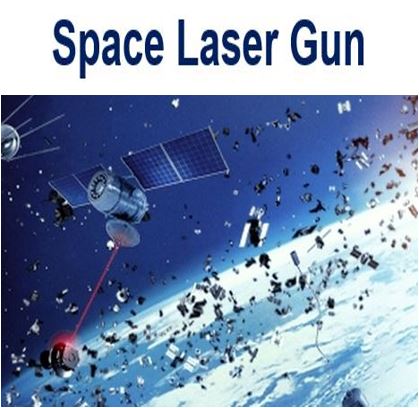If an international team of scientists has its way, the International Space Station will be fitted with a laser weapon to shoot at space debris, which has become a growing hazard for orbiting satellites. So, are humans about to have their first space weapon?
According to NASA and the European Space Agency, there are about 3,000 tons of space debris flying around the Earth. There is a real risk that an impact with the International Space Station (ISS) could cause serious damage and threaten the lives of the resident astronauts.
Scientists from the Riken Institute, Japan; APC-CNRS Paris7 University, France; Ecole Polytechnique, France; and the Istituto Nazionale di Fisica Nucleare, Italy, published their proposal in the academic journal Acta Astronautica (citation below).

Would a laser device help keep the International Space Station and its human residents safe?
The authors would like to see the EUSO (Extreme Universe Space Observatory) telescope that is currently fitted to the ISS transformed into a device for seeking out hazardous space debris.
When a piece of perilous debris is spotted, a laser beam would be directed at it until it went either out of orbit or burnt up as it fell into the Earth’s atmosphere.
Space junk is a growing problem
Space debris, also called ‘space junk’, has become a serious problem for satellite companies. Some satellites have been destroyed after crashing into large pieces of junk.
Several proposals have been put forward to deal with space debris, from using nets to catch the debris to deflecting it with powerful blasts of gas.
In this latest proposal, the authors suggest initially trying out a laser shooter fitted to a small telescope on board the ISS. If that proves successful, then a large one could be installed, they say.
The researchers envisage a three-metre telescope with a laser built out of 10,000 fibres. The ‘weapon’ would have a 100 kilometre range.
In an Abstract in the journal, the authors wrote:
“We present here designs for a staged implementation of an orbiting debris remediation system comprised of a super-wide field-of-view telescope (EUSO) and a novel high efficiency fibre-based laser system.”
Citation: “Demonstration designs for the remediation of space debris from the International Space Station,” Toshikazu Ebisuzaki, Mark N. Quinn, Satoshi Wada, Lech Wiktor Piotrowski, Yoshiyuki Takizawa, Marco Casolino, Mario E. Bertaina, Philippe Gorodetzky, Etienne Parizot, Toshiki Tajima, f, Rémi Soulard, Gérard Mourou. Acta Astronautica. July-August 2015. Pages 102-113. DOI: 10.1016/j.actaastro.2015.03.004.
NASA Video – Space debris
The NASA animation depicts the distribution and movement of man-made objects orbiting Earth.

